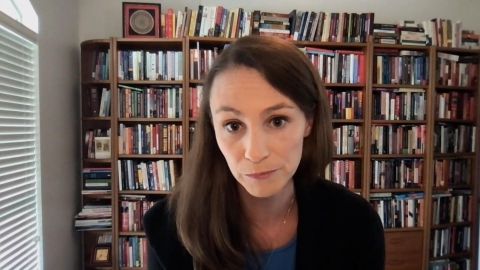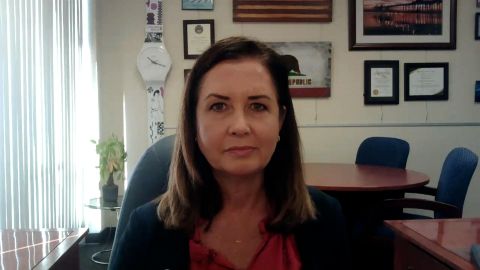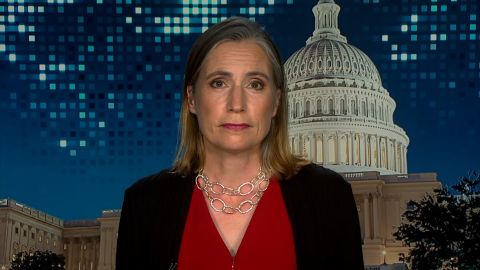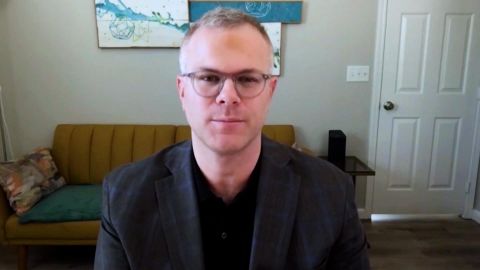Read Transcript EXPAND
BIANNA GOLODRYGA: Well, we turn now to the devastating impact of America’s opioid crisis. In September 2019, Purdue Pharma the makers of oxycontin, a mass marketed pain medication, filed for bankruptcy to protect itself from hundreds of lawsuits for its part in the U.S. overdose epidemic. Someone who has experienced firsthand the deadly cost of these highly addictive drugs is Ryan Hampton. After more than a decade of using opioids, he is in long-term recovery. Ryan was also part of a committee set up by the Department of Justice that acted as a watchdog during the process, representing all of Purdue’s creditors, from states and hospitals to people like him. In his new book, it’s out today, “Unsettled” in an inside story of those proceedings, a David versus Goliath tale as those impacted sought justice. Here he is speaking to our Hari Sreenivasan.
(BEGIN VIDEO CLIP)
HARI SREENIVASAN: Ryan Hampton, thanks for joining us. First of all, you had a rare vantage point into the process of the bankruptcy settlement with Purdue Pharma. You sat on something called the UCC, the Unsecured Creditor’s Committee. So, there are nine seats on this UCC that are supposed to kind of represent all 600,000 claims, four of the nine are victims. Maybe, if you don’t mind, telling the audience why are you specifically sitting in the seat of one of the victims?
RYAN HAMPTON, AUTHOR, “UNSETTLED”: Sure. So, I’m someone who is in recovery from a decade-long opioid use disorder, addiction. I was homeless. It, you know, kicked off with me in a doctor’s office in 2003. I got caught up in the Florida pill mills pretty badly. I was prescribed oxycontin, which led to multiple overdoses, which led to over half a million dollars in treatment bill. So, I was appointed as a victim member of the committee. It was something that I applied for. I had to go in and meet with the trustee and share my story. And, you know, the hardest part for me was I had to be impartial. You know, I’m someone who, prior to joining the committee, led — co-led the largest protest in front of Purdue in 2018. I had called out the company and the Sacklers for years for their criminal actions. I had written about it. So, what I saw from the outside then moving on to the inside, it was just a completely different ball game. It was like knowing how to play football really well but then ending up on an ice-skating rink. You know, never skating once in your life. And I think it’s important to note, too, that the Unsecured Creditor’s Committee, you know, not only were we just this mega plaintiff, but we had broad powers, right? I mean, we subpoenaed records. We took depositions of the Sackler family. Our committee counsel and consultants reviewed millions of pages of documents. Many of the documents that you hear about that the, you know, House Oversight Committee has released and even some that serve attorney’s general has put out there was the result of our work. It was the result of the work of our committee. We worked for over a year on discovery. And what we found was fascinating.
SREENIVASAN: So, you were there on behalf of the 127,000 other individuals. So, some of those people might be family members who have lost loved ones, family members who are living with loved ones with severe health issues now, right? So, you’re getting from the outside literally the guy screaming at the fence to the inside, you are kind of, I assume, at that point, feeling good. You’re like, hey, I’m sitting across the table from the people who I’m trying to get attention from. And then, when did this turn for you? When did you feel like instead of football you were on an ice-skating rink?
HAMPTON: The big turning point for me was I thought it was a shame and actually a crime that so much money, when I started seeing the legal bills coming out of the consultants, even our attorneys at the UCC, the attorneys representing Purdue, the attorneys representing other creditor groups, when I started to see those bills and realized that over $1 billion would be paid to a handful of lawyers, likely way less than 1,000 lawyers in this case, throughout the case, yet victims and communities in need wouldn’t receive a dime until the end of the case, I said, we need to do something about this, and we proposed this emergency relief fund. And I thought this was a no brainer, right? I was like, great. Get $200 million on the ground right away where it needs to go to help curb this, you know, over — you know, just growing overdose crisis. And that initiative was killed. It was killed not by Purdue. It was killed not by the Sacklers. It was killed by many of the same state attorneys general who were grabbing the microphone and saying that they were doing this to help communities and to help victims. And I realized at that point — because they felt if the money didn’t go to them, the money shouldn’t be spent at all. I realized at that moment that we were up against a much bigger machine than just Purdue and the Sacklers. Purdue and Sacklers, they were just writing the checks at this point. How the money was getting spent was up to the government, it was up to the states, it was up to the municipalities, they played the outsize role in the bankruptcy, Purdue bankruptcy, which would never happen in any other mass bankruptcy because they thought we did this to ourselves. And some of those deputy attorneys general and attorneys general actually said those very words, and I write about it in the book.
SREENIVASAN: Help people understand who are watching this, of the bankruptcy, as it stands today, who is getting what from this?
HAMPTON: Yes. So, the victims fund, which is most important to me was negotiated at $750 million. Now, to give you the larger scale, the overall settlement is expected to be somewhere between $9 to $10 billion depending on how insurance dollars pay out, the insurance — the claims insurance coming out of Purdue. That’s about 7.5 percent of the total settlements split around approximately 130,000. Now, that $750 million number, though, can be misleading because that’s before attorneys take their cut. So, attorneys, the Tort lawyers, you know, plaintiff’s lawyers in the case, will average somewhere between 30 to 40 percent of that $750 million. So, that number very well likely could be under 500 million that all the victims have to split. Insurance companies, hospitals, CVS pharmacies, they shared about another $700 million in total. And then states, municipalities take the rest of the dollars. I will repeat, though, it is notable that lawyers and consultants in this case will take well over $1 billion, less than 1,000 of them, which is more than 130,000 or so victims will have to share. It’s — if you didn’t live it like I did, it’s almost unbelievable. I mean, you just can’t imagine a world or a system that’s set up with just such gross wealth inequality and injustice.
SREENIVASAN: The State of Massachusetts, the State of New York have kind of put out similar statements about what they’re going to do with the money. And I want to read one from Massachusetts here. We will use every piece of evidence and every dollar we achieved in our case to expand prevention, treatment and recovery for the families who have been hurt in this crisis. New York says, we’ll be able to more quickly invest these funds in prevention, education and treatment and put an end to the delays and legal maneuvering that could possibly continue for years and across multiple continents. Why don’t you believe that?
HAMPTON: Well, I’ll believe it when I see it. First of all, because the states have done a terrible job in spending money so far when it comes to abating the opioid overdose crisis. I mean, there was an inspector general’s report with HHS, there was a government accountability report that came out about six months ago that shows that the way the states have actually been spending down their money is unacceptable. There’s still a tremendous amount of money that is left unspent from the federal dollars they received. Look, I’m not in the business of saying, hey, the states shouldn’t be doing more. They absolutely should be doing more. But I pay taxes for those services. You pay taxes for those services. Your viewership pays taxes for those services. We know that to actually truly make a dent in combatting the overdose crisis, we need upwards of $20 to $30 billion a year. $9 billion, $7 billion, the money that’s going to be coming out of these settlements spread out over a decade or two decades, that’s not going to cut it. Why are states going to rob victims, right, of the only opportunity that they have for any type of justice in this case. The only talking points they have is that, we’re going to spend it, you know, forward. We’re going to make sure it goes to the right places. The whole emergency relief fund, that $200 million that I — that we just discussed really opened my eyes that they don’t want to listen to community-based advocates, community-based providers on how the dollars should be spent. Those systems that you just mentioned are very broad strokes. Prevention can mean a lot of things, right? Prevention can mean more criminal justice systems. I’ve seen the abatement plans, there’s tons of money in there in terms of what I feel is criminalizing addiction. Once again, treatment is kind of a buzz word out there. But what type of treatment are we actually providing? Recovery is another buzz word out there. But what type of recover? Are we providing harm reduction services? Are we providing peer services? Things that we have data that are new that we know will save more lives. Now, I brought up a lot of this to the state attorney general during that process and proposed that we start spending money that way, not just me but several other public health experts. But they didn’t want to listen to anything we had to say.
SREENIVASAN: I want to talk about the Sacklers as well. Because you were in the rare position to actually have them in depositions. You were able to go through discovery, meaning look at the back-and-forth e-mails again that some of those e-mails that you found are the ones that made their way to Congress. But one of the things that was intriguing to me was that that you found between 1997 and 2007 the Sackler family who controlled the company, so it’s their cash register, so to speak, they withdrew about $1 billion at a pretty steady pace, 200 million or so a year. And then, you found the four years following, about 2008 and more, they took out $7 billion. What happened at that moment that you think impacted the Sackler’s family decision to take out a lot more money from the company?
HAMPTON: Well, I think that this was clear evidence that the Sacklers knew what was coming, right? So, 2007 was when the consent judgment, when Purdue pled guilty for the first time in federal court. And there actually — and I write about it in “Unsettled” there’s an e-mail that was exchanged between certain Sackler family members the day after Purdue pled guilty talking about some of the options in terms of diversifying where the Sackler money is. And you could start to see those withdrawals happen very quickly because the family, the — they like to call themselves “the family.” That’s how they referred many times in their own e-mails to each other, the family was afraid that they were going to get sued. That they were going to have liability. So, I think that there is a very reasonable case to be made that that’s when they started to hide assets, right? That’s when they started to make it more difficult to trace their money. They knew what was coming down. And eventually it did. Sadly, victims aren’t going to benefit much, though, from, you know, the outcome of this case. But the Sacklers, you know, were essentially scared.
SREENIVASAN: So, to be clear, the settlement that’s kind of agreed upon now, does it go through to the individual bank accounts of the Sacklers and take money back that they might have socked away?
HAMPTON: Right. Great question. No, it does not. So, we spent about a year trying to track down Sackler money, and it is almost impossible forensically. Given the way that they set up what are called IHCs, these independent associated companies, right? It’s their — you know, the different trusts that were set up in different countries, under different names, different associates of Purdue and Sackler family members. Very difficult to track down. But it does not mean that we go in and take the money from the Sacklers. Essentially, the Sacklers are receiving non-consensual third-party release. They are, you know, contributing close to $4.5 billion on a payment schedule where they’re actually writing a check into the bankruptcy to receive that release. But — you know, one of the more maddening things when you look at Sackler wealth, right, is that by the time they finish paying the settlement, which is, you know, eight to nine years, they actually will end up richer than they are today even after paying back themselves the money that they paid into the bankruptcy. Just assuming a standard healthy interest rate. It’s — you know, given the extraordinary amount of wealth that they have, it’s average that they probably will end up somewhere, you know, starting right now around $11 billion, they could end up somewhere with their investments and interest rates closer to $15 to $16 billion. So, there’s the possibility that they may actually net $1 billion if they do nothing else after this.
SREENIVASAN: So, you had the opportunity to depose one of the Sacklers. What did you find in that conversation?
HAMPTON: You know, I tended, you know, much like we do these days, on Zoom. All of the Sackler depositions live. There were about 50 of us. It ranged from 50 to 60 of us that were these Zoom sessions and they were very long. Some went into several days all day. The one that I would, you know, like to mention was Richard Sackler. Because Dr. Richard Sackler was really the head of the family. He’s the one where a lot of the discussion and I guess credit, you could say, goes to for all the crimes that have happened with oxycontin. And he was incredibly casual. He laid back in his chair. He laughed. He smirked a little bit. He was slow in his speaking. And he felt — it felt as if you were sitting across the table from a guy who knew that no matter what, no matter what we dug up on him or no matter what was revealed in this process or no matter how many lives and families he destroyed and possibly killed, he knew he was going to get off. And so, he just kind of skated by. And as I say it in book, and I know we’re on public television, the best way to describe is zero Fs given. He did not care. He did not care. He knew that at the end of this, the outcome, you know, was casts. It was cast in stone. And quite frankly, it was cast in stone before we even started this process.
SREENIVASAN: I mean, do things like, you know, admitting wrong doing, making an apology, things that the Sackler family has not done, does that matter in how you perceive this whole process to have been?
HAMPTON: I truly believe that the Sacklers believe that they haven’t done anything wrong, which is really just this odd world that they live in. They’re not on the ground. You know, this is what we call in the United States billionaire justice. And at this point, I’m not sure a Sackler family apology goes very far with me. I will tell you what would have gone far, though, is full Sackler wealth. The victims in this crisis, the victims of Purdue’s greed and crimes and the Sackler crimes should have been entitled to full Sackler value and it could have looked several billion dollars, it could have like all $4.5 billion from them. But sadly, we got nothing. I don’t know what many victims are going to do, you know, with $1,500, $1,600 check and an apology from Richard Sackler. I don’t think many of us really care, you know, about an apology from them. A lot of us believe they — there should be a criminal trial. And that’s still could be on the table. So, they are only getting a civil release in this case. They’re not getting a criminal release. The sad part about it is though, is that the Department of Justice — the United States Department of Justice, has yet – – or any United States attorney has yet to bring a criminal charge against the Sackler family. All of these attorneys general, there are 48 of them in — that were participating in the Purdue bankruptcy, not one single one of them has brought a criminal charge against the Sackler family. So, I would like to flip the table and ask them, why is that? Why haven’t they changed this family when they still can? They still can today. They have yet to do that.
SREENIVASAN: The book is called “Unsettled.” Ryan Hampton, thanks so much for joining us.
HAMPTON: Thank you.
About This Episode EXPAND
Fiona Hill; Kim Carr; Sheena Greitens; Ryan Hampton
LEARN MORE



